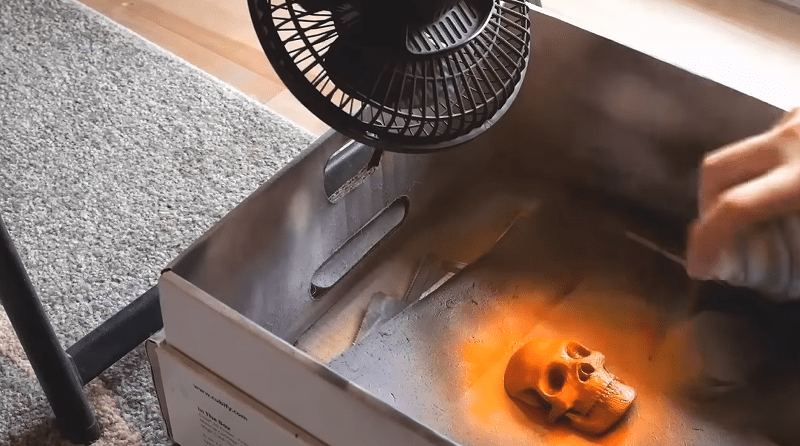There was a time when most 3D printers used ABS plastic. It stinks, is probably bad for you, and tends to warp unless printed in a heated enclosure. So most people have gone to something else, mostly PLA. But ABS also dissolves in a readily-available solvent, acetone, and this is useful for smoothing the layer artifacts from a 3D print. [3DSage] has a technique that works for PLA or — he says — probably any filament. You can see what he’s doing in the video below.
The video starts out with a recap of things most Hackaday readers will already know. But hang in there because at about 1:20, he reveals his method.
The technique involves using plastic-compatible paint and fast-drying polyurethane. He quickly sprays a thin coat of paint and then a thin coat of polyurethane on the part and uses a fan to rapidly dry the mixture before it can run. The two sprays merge to form a coating. He does apply several coats, leaving half an hour to dry between layers, and waits overnight before applying the final coat.
The results look pretty good. This is more like a coating than truly smoothing, but it does fill in the gaps and ridges nicely. As [3DSage] points out, you can print with a larger layer height, and you can change the final color by just changing paint colors.
It certainly looks easy enough to try out. A trip to a big box store and a fiver should put you in business. Our own [Donald Papp] has done something similar with UV resin. The paint method does seem safer than torching your prints.
















I would test with just spray paint to see if the poly is really necessary. I bet pre-heating the part and then hitting with a hair dryer instead of just a fan would make the paint dry fast enough on its own.
We just use automotive spray paint with filler. 2-3 coats and all the lines are gone. I prefer Rustoleum $4 a can give or take and it fills even the largest gaps with 3-5 coats. Then it sands like a wet dream if you want it silky smooth for the polished look. I use it as my base coat because it is also a primer – then I have others do the fine detail work which requires skill I dont have lol.
I think this is the way to go. For more functional parts that need to take a beating I’ve used Truck Bed Liner paint with good results.
Uh, 400ml Rustoleum spray is ~$18,37 here (DK) – any other brands come to mind?
Sorry you will have to experiment with other brands. There are many of paints will filler – my local hardware store has 5 brands with filler for$4usd-$12usd. I just grabbed the first one on the shelf to try it and I got lucky it worked great so I never tryed again.
Just look for a cheaper domestic or EU brand which may have the same description as in the US: filler primer. Less often, it can also be called “high build primer”, the “high build” referring to its high layer thickness.
That’s what I use, and I also sand down the areas that have few details to get them really smooth. For filling really bad areas like an overhang I just use wood filler (acrylic based filler).
Be VERY carful when using 2K PUR as an aerosol! That stuff contains some NASTY organic compounds – it’s all good after being correctly mixed and cured, but especially the hardener is all sorts of bad for you.
Here is another method of smoothing…. https://youtu.be/vQc5TBPF8uw
I wonder if at some point, the paint’s own solvent is starting to dissolve the outer layer of the print, and allowing it to re-form in a smoothed-by-surface-tension shape. Are there different paints that would enhance this effect?
If the spray paint contained a solvent that will dissolve PLA – like tetrahydrofuran or dichloromethane – then I suppose that would work, but I wouldn’t expect to see either.
(I’ve had mixed results with THF. One batch of white PLA dissolved readily, leaving the trace of white pigment undissolved and settled to the bottom of the clear solution, but a different batch of clear PLA refused to dissolve.
DCM readily, easily dissolves PLA, as it does many plastics.)
You’ll probably have better results with “spray putty” products that are specifically designed to be a bit “heavy” to fill in smooth surfaces (kinda like very fine resolution Bondo, applied and sanded as the final step before the primer and the paint) as opposed to ordinary aerosol paint.
The technique I have discovered is to use cheap dollar store two part epoxy as a brush on smoother -polisher. It thins easily with alcohol, so you can easily get the consistency you want. Use before painting to smooth and after painting for the high gloss shine.
“..use cheap dollar store two part epoxy as a brush on smoother -polisher. It thins easily with alcohol..”
Interesting, I’ll need to try that.
I’m surprised it is soluble in alcohol but I guess the monomer probably is, I’ve never thought about it.
I presume isopropanol would do the trick. Failing that I’ll grab some methylated spirits.
I might also try turpentine substitute… all out of doors of course.